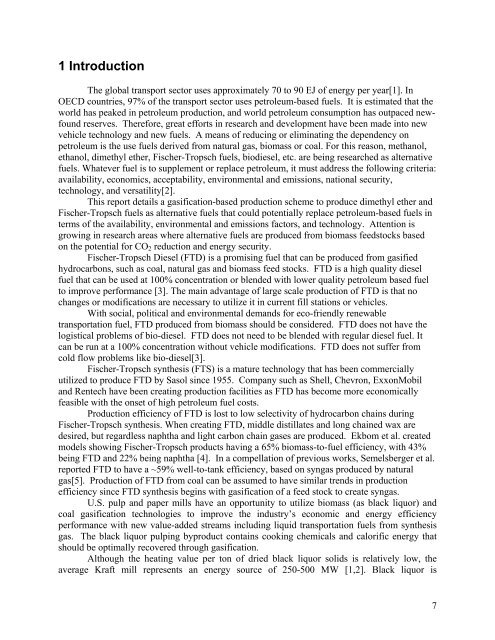Novel Design of an Integrated Pulp Mill Biorefinery for the ...
Novel Design of an Integrated Pulp Mill Biorefinery for the ...
Novel Design of an Integrated Pulp Mill Biorefinery for the ...
Create successful ePaper yourself
Turn your PDF publications into a flip-book with our unique Google optimized e-Paper software.
1 Introduction<br />
The global tr<strong>an</strong>sport sector uses approximately 70 to 90 EJ <strong>of</strong> energy per year[1]. In<br />
OECD countries, 97% <strong>of</strong> <strong>the</strong> tr<strong>an</strong>sport sector uses petroleum-based fuels. It is estimated that <strong>the</strong><br />
world has peaked in petroleum production, <strong>an</strong>d world petroleum consumption has outpaced newfound<br />
reserves. There<strong>for</strong>e, great ef<strong>for</strong>ts in research <strong>an</strong>d development have been made into new<br />
vehicle technology <strong>an</strong>d new fuels. A me<strong>an</strong>s <strong>of</strong> reducing or eliminating <strong>the</strong> dependency on<br />
petroleum is <strong>the</strong> use fuels derived from natural gas, biomass or coal. For this reason, meth<strong>an</strong>ol,<br />
eth<strong>an</strong>ol, dimethyl e<strong>the</strong>r, Fischer-Tropsch fuels, biodiesel, etc. are being researched as alternative<br />
fuels. Whatever fuel is to supplement or replace petroleum, it must address <strong>the</strong> following criteria:<br />
availability, economics, acceptability, environmental <strong>an</strong>d emissions, national security,<br />
technology, <strong>an</strong>d versatility[2].<br />
This report details a gasification-based production scheme to produce dimethyl e<strong>the</strong>r <strong>an</strong>d<br />
Fischer-Tropsch fuels as alternative fuels that could potentially replace petroleum-based fuels in<br />
terms <strong>of</strong> <strong>the</strong> availability, environmental <strong>an</strong>d emissions factors, <strong>an</strong>d technology. Attention is<br />
growing in research areas where alternative fuels are produced from biomass feedstocks based<br />
on <strong>the</strong> potential <strong>for</strong> CO2 reduction <strong>an</strong>d energy security.<br />
Fischer-Tropsch Diesel (FTD) is a promising fuel that c<strong>an</strong> be produced from gasified<br />
hydrocarbons, such as coal, natural gas <strong>an</strong>d biomass feed stocks. FTD is a high quality diesel<br />
fuel that c<strong>an</strong> be used at 100% concentration or blended with lower quality petroleum based fuel<br />
to improve per<strong>for</strong>m<strong>an</strong>ce [3]. The main adv<strong>an</strong>tage <strong>of</strong> large scale production <strong>of</strong> FTD is that no<br />
ch<strong>an</strong>ges or modifications are necessary to utilize it in current fill stations or vehicles.<br />
With social, political <strong>an</strong>d environmental dem<strong>an</strong>ds <strong>for</strong> eco-friendly renewable<br />
tr<strong>an</strong>sportation fuel, FTD produced from biomass should be considered. FTD does not have <strong>the</strong><br />
logistical problems <strong>of</strong> bio-diesel. FTD does not need to be blended with regular diesel fuel. It<br />
c<strong>an</strong> be run at a 100% concentration without vehicle modifications. FTD does not suffer from<br />
cold flow problems like bio-diesel[3].<br />
Fischer-Tropsch syn<strong>the</strong>sis (FTS) is a mature technology that has been commercially<br />
utilized to produce FTD by Sasol since 1955. Comp<strong>an</strong>y such as Shell, Chevron, ExxonMobil<br />
<strong>an</strong>d Rentech have been creating production facilities as FTD has become more economically<br />
feasible with <strong>the</strong> onset <strong>of</strong> high petroleum fuel costs.<br />
Production efficiency <strong>of</strong> FTD is lost to low selectivity <strong>of</strong> hydrocarbon chains during<br />
Fischer-Tropsch syn<strong>the</strong>sis. When creating FTD, middle distillates <strong>an</strong>d long chained wax are<br />
desired, but regardless naphtha <strong>an</strong>d light carbon chain gases are produced. Ekbom et al. created<br />
models showing Fischer-Tropsch products having a 65% biomass-to-fuel efficiency, with 43%<br />
being FTD <strong>an</strong>d 22% being naphtha [4]. In a compellation <strong>of</strong> previous works, Semelsberger et al.<br />
reported FTD to have a ~59% well-to-t<strong>an</strong>k efficiency, based on syngas produced by natural<br />
gas[5]. Production <strong>of</strong> FTD from coal c<strong>an</strong> be assumed to have similar trends in production<br />
efficiency since FTD syn<strong>the</strong>sis begins with gasification <strong>of</strong> a feed stock to create syngas.<br />
U.S. pulp <strong>an</strong>d paper mills have <strong>an</strong> opportunity to utilize biomass (as black liquor) <strong>an</strong>d<br />
coal gasification technologies to improve <strong>the</strong> industry’s economic <strong>an</strong>d energy efficiency<br />
per<strong>for</strong>m<strong>an</strong>ce with new value-added streams including liquid tr<strong>an</strong>sportation fuels from syn<strong>the</strong>sis<br />
gas. The black liquor pulping byproduct contains cooking chemicals <strong>an</strong>d calorific energy that<br />
should be optimally recovered through gasification.<br />
Although <strong>the</strong> heating value per ton <strong>of</strong> dried black liquor solids is relatively low, <strong>the</strong><br />
average Kraft mill represents <strong>an</strong> energy source <strong>of</strong> 250-500 MW [1,2]. Black liquor is<br />
7

















